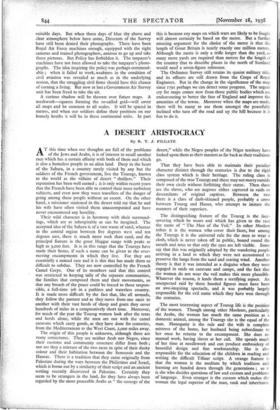A DESERT ARISTOCRACY
By R. T. J. FILGATE
Their wild character is in harmony with their surround- ings, which are as inhospitable as can be imagined. The accepted idea of the Sahara is of a vast waste of sand, whereas in the central region between five degrees west and ten degrees east, there is much more rock than sand, and the principal feature is the great Hoggar range with peaks as high as 3,000 feet. It is in this range that the Touregs have made their home, if such a name can be given to the ever- moving encampments in which they live. For they are essentially a nomad race and it is this that has made them so difficult to subdue. They are now controlled by the French Camel Corps. One of its members said that this control was restricted to keeping tally of the separate communities, the families that composed them and their movements, so that any breach of the peace could be traced to those respon- sible, a full-time job in a pathless and waterless country. It is made more difficult by the fact that, like all nomads, they follow the pasture and as they move from one oasis to another with their vast herds of sheep and goats they cover hundreds of miles in a comparatively short time. Moreover, for much of the year the Toureg women look after the tents and herds alone, while the men are out with the camel caravans which carry goods, as they have done for centuries, from the Mediterranean to the West Coast, 2,000 miles away.
The origin of this people is unknown, although there are many conjectures. They are neither Arab nor Negro, since their customs and community structure differ from both ; nor are they a mixture of the two races in spite of their dusky colour and their habitation between the Senoussis and the Hausas. There is a tradition that they came originally from Palestine during the wars between the Philistines and Israel, which is borne out by a similarity of their script and an ancient writing recently discovered in Palestine. Certainly they seem to be strangers in the land, for they have always been regarded by the more peaceable Arabs as " the scourge of the desert," while the Negro peoples of the Niger territory have looked upon them as their masters as far back as their traditions go.
That they have been able to maintain their peculiar character distinct through the centuries is due to the rigid class system which is their heritage. The ruling class is composed of the true Touregs and these may not marry outside their own circle without forfeiting their status. Then there are the slaves, who are negroes either captured in raids or descendants of original captives. Between the two there is a class of dark-skinned people, probably a cross between Toureg and Hausa, who attempt to imitate the manners of their superiors.
The distinguishing feature of the Toureg is the face- covering which he wears and which has given to the race the name of " The Men of the Veil." In other Moslem tribes it is the women who cover their faces, but among the Touregs it is the universal rule for the men to wear a cloth, which is never taken off in public, bound round the mouth and nose so that only the eyes are left visible. Some say that this was originally adopted by the wandering people arriving in a land to which they were not accustomed to preserve the lungs from the sand and searing wind. Another theory is that it was intended as a disguise when they were engaged in raids on caravans and camps, and the fact that the women do not wear the veil makes this more plausible. Whatever the reason, it lends them a terrifying aspect. An unexpected raid by these hooded figures must have been an awe-inspiring spectacle, and it was probably largely responsible for the evil name which they have won through the centuries.
The most interesting aspect of Toureg life is the position of the women. Though among other Moslems, particularly the Arabs, the woman has much the same position as a domestic animal, among the Touregs she is the equal of the man. Monogamy is the rule and the wife is complete mistress of the home, her husband being subordinate to her once he returns to the encampment. She does no manual work, having slaves at her call. She spends much of her time at needlework and can produce embroidery of beautiful design and fine workmanship. She is also responsible for the education of the children in reading and writing the difficult Tifinar script. A strange feature is that the woman is the medium by which tradition and learning are handed down through the generations ; so ii is she who decides questions of law and custom and problems of language. Even stranger is the custom which makes the woman the legal superior of the man, rank and inheritance being communicated through her instead of through her husband. The men of the nobility are penalised for marrying beneath them by loss of status, but the women are never allowed to marry outside their class, so that the line is main- tained intact.
Whether the Touregs will be able to retain their exclusive- ness is doubtful ; class distinctions are already breaking down under the influence of European ideas. Now that they have been deprived by the French of the overlordship of the Niger peoples, the slave class is disappearing. At the same time the " plebeians " are becoming wealthy and powerful and there is more intermarrying with the aristocracy than there was before. The development of military outposts, such as Agades, into large towns in the centre of their country, will do much towards ending the nomad life upon which the Toureg character depends.

























































 Previous page
Previous page